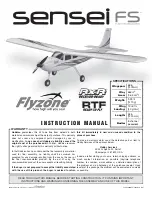
14
❏
2. On the underside of the wing there are plastic aileron
servo covers which have circular decals on them. The center
of these circles are the ideal balancing point of the plane
(center of gravity). Lift the plane up by placing a fi nger on
each circle as shown. If the plane is properly balanced then
it should sit on your fi ngers with the tail level. If the tail hangs
low then the plane is tail heavy. If the tail is high then the plane
is nose heavy. You can safely move your fi ngers as much as
1/4" [6.4mm] forward or aft of the circle center in order to get
the tail to sit level (the diameter of the circle is a little less than
1/2", or make marks on the wing with a ruler). If the plane still
cannot be balanced within the range of 1/4" forward or aft of
the circles then additional weight will need to be added until
it does balance within the range. The following steps instruct
you how to add weight and where.
NOTE:
Even if your Sensei balances perfectly, later you may
wish to change its fl ying characteristics by moving the C.G.
forward or aft. Moving the C.G. forward (nose heavy) will make
the plane more stable which may be better for windier days,
but this will also make it less maneuverable. Moving the C.G.
back (tail heavy) will make the plane more maneuverable which
is good for experienced pilots who wish to perform aerobatics.
In any regard, never fl y the model with the C.G. outside the
recommended range.
❏
3. If the Sensei does not balance between the lines,
determine the amount of weight required to balance it by
placing segments of Great Planes stick-on weight (GPMQ4485)
or similar weight along the edge in the battery compartment
or on the top of the stabilizer. Do not attach it yet.
❏
4. Once the plane balances and you know how much weight
will be required, permanently stick it into position. The best
place to add nose weight is in the battery compartment. If tail
weight is required, simply attach it to the side of the fuselage,
under the horizontal stabilizer.
❏
5. Once the weight is attached, recheck the C.G. to make
certain the plane still balances at the correct C.G. Once
fi nished, remove the battery. Never charge the battery while
it is installed in the model.
Important ESC Information
●
The ESC included with the Sensei has a safe start. If the
motor battery is connected to the ESC and the throttle stick
is not in the low throttle (idle) position, the motor will not start
until the throttle stick is moved to the low throttle position.
Once the throttle stick is moved to the low throttle position,
the motor will give a short beep. The motor is now armed
and will start when the throttle stick is moved.
●
If you do not hear the short beep indicating the motor is
armed, lower the throttle trim by pressing the trim button
in the down direction repeatedly.






































